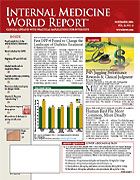Publication
Article
Internal Medicine World Report
First DPP-4 Poised to Change the Landscape of Diabetes Treatment
Author(s):
The European Association for the Study of Diabetes
COPENHAGEN, Denmark—Concomitant use of the dipeptidyl peptidase IV (DPP-4) enzyme inhibitor sitagliptin phosphate (Januvia; Merck) with metformin (Glucophage) in patients with type 2 diabetes improved glycemic control significantly more than therapy with either agent alone, according to new data presented at the annual meeting of the European Association for the Study of Diabetes.
The 24-week, randomized, double-blind, placebo-controlled study compared the use of the 2 drugs in combination and as monotherapies in 1056 untreated patients with type 2 diabetes (average age, 53.5 years; male to female ratio, about 50:50).
IMWR
“The most important aspect of this study is that giving sitagliptin and metformin at the same time gave a significant and additive lowering of the blood sugar levels, consistent with the different ways the 2 drugs work,” Barry J. Goldstein, MD, PhD, director, Division of Endocrinology, Diabetes and Metabolic Diseases, Jefferson Medical College, Philadelphia, told . He noted that “the results showed that they can work very well together, without any difference in side effects compared with using metformin alone.”
Dr Goldstein reported results from 1 arm of the study that included 178 patients randomized to sitagliptin 50 mg twice daily plus metformin 1000 mg twice daily, or to placebo. (Further results are expected to be released later this year.)
This combination regimen resulted in a significant mean placebo-subtracted reduction in hemoglobin (Hb) A1c of 2.1% from a mean baseline of 8.8%. The regimen was generally well tolerated, with no meaningful differences in tolerability compared with metformin alone.
Dr Goldstein added, “Many more patients were able to get to the goal of controlling their glucose values with the 2 medications together. In the current management of type 2 diabetes, we are using more combinations of the available therapies. Metformin is frequently used as initial therapy in treating diabetes, but it is often not effective enough as a single therapy, and it has gastrointestinal side effects, especially at higher doses.”
An advantage of sitagliptin, based on early reports, may be its side-effect profile, he said. “The available data show that sitagliptin is well tolerated—it will be an advantage in our management of patients with type 2 diabetes—especially in its potential use in combination with metformin.”
Noting that the DPP-4 class has the potential to profoundly affect the treatment landscape for type 2 diabetes, Fredric Cohen, MD, founder and president of Pharma Growth Strategies, a specialized management consultant to the pharmaceutical and biopharmaceutical industries, told IMWR that he is still awaiting evidence showing that “there are no important adverse effects on cell-mediated immunity.”
Dr Cohen said that this might require more clinical data than is available now and depends on the evidence the manufacturer has collected during the premarketing phase.
“Assuming that the potential adverse effects of the class are not realized, this class has the potential to compete with metformin and sulfonylureas for monotherapy of early diabetes, and also for pharmacotherapy of prediabetes,” Dr Cohen said.
Primary care doctors should read the drug label carefully before prescribing any drug for the first time, especially a new agent like sitagliptin, Dr Cohen cautioned. “It sounds obvious, but my own research and research from others, including the FDA, indicates that it happens far too frequently.”
But, he added, “some authorities suggest waiting a year before prescribing a new drug. I don’t subscribe to this view as a general rule. In the year that doctors are waiting, the disease is not. In the case of early diabetes, there are multiple reasonable treatment options available; however, none is ideal. If an abundance of evidence indicates that sitagliptin is safe, effective, and might delay the progression of diabetes, I see little reason not to consider it as a valid treatment option. It will all come down to the weight of evidence.”
Sitagliptin is the first agent in this new class of oral therapy for diabetes to receive FDA approval. A second agent, vildagliptin (Galvus; Novartis), is currently under FDA review.
Sitagliptin has been approved as monotherapy and as add-on therapy to metformin (Glucophage) or a thiazolidinedione for patients with uncontrolled type 2 diabetes despite diet and exercise.






